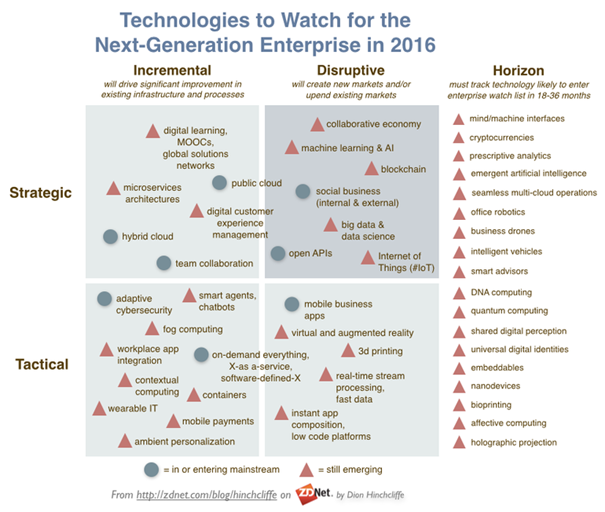One Eye on the Future
16th of August 2016Perusing the ZDNet blog website, I came across this post by Dion Hinchcliffe and his view on which technologies will become major players in the months to come. Most of the items in his quadrants are already known to me, but some of them are not, and as such merit a few words. It does seem that a large number of these technologies are either in the realm of Artificial Intelligence or in the realm of Big Data (or Data Analytics as Gartner rebranded the term last year).
I purposely did not look over the Horizon topics, as the author himself didn’t go into detail about them. I suppose a future post will inform me of the level of disruptiveness these (for the moment) buzzwords will hold. That is the sweet (or not so sweet depending on your views) thing about the wonderful world of IT consulting. There is always more and new stuff to get to know. Never a dull moment to be had for those of an inquisitive mind.

Blockchain (marked as Disruptive and Strategic) made its debut in the world with the introduction of BitCoin, and in essence is nothing more than a universal ledger of transactions, both robust and secure. Hinchcliffe states this technology to be disruptive as venture investment for it has surpassed $1.1 billion and is expected to continue. It made me think that I was missing something as I associated this technology mainly in the financial sector. Doing a bit of digging, I came across another blog post (this time on LinkedIn) where the potential for more was made evident. I was delighted to learn that one of the initiatives of the Human Brain Project was to use Blockchain and the linked boxed cyber idea as a part of their Functional Magnetic Resonance Imaging (fMRI) research. In any case, it has sent a boos through the AI community and the Singularity idea of Kurzweil seems to emerge once again. I just hope that this supposed boost in intelligence doesn’t result in the creation of Algernons.
Another Strategically Disruptive technology that caught my eye is the Collaborative Economy. The term is unfamiliar to me, but as I read the explanation by the author, I am informed that this is the business model of for example Uber or AirBnb where we rent the use of possessions for a specific purpose (your car as taxi, or your apartment as hostel). This idea is not so new, as conceivably timesharing was already a prelude to this type of arrangement, using ownership instead of usage.
Moving on to other quadrants, I spot the term Fog Computing. Once again, it is a concept that I knew under a different name, being the Internet of Everything or as the author describes it: The use of a collaborative cloud of end-user clients or nearby edge devices that can contribute bandwidth, storage, and other resources on demand for higher performance and fault tolerance for demand applications, without the limitations of accessing far away cloud data centers. These edge devices are to reduce (read: aggregate) the amounts of data needed to be sent and received from data centers that would only contribute raw calculation power on aggregated data sets.
Last term to look up is Ambient Personalization. This trend of personalization in marketing strategies seems not that new to me (as Customer Intimacy is one of the three main business strategies described by Treacy and Wiersema). However, its importance seems to gradually increase over conventional marketing approaches, as it tops the 2016 digital marketing trends according to the author. I want to believe this at face value (as it makes sense), and reports by sites such SmartInsights, MarketingDive and Adestra seem to corroborate this statement.
All in all, most of the terms that didn’t immediately ring a bell, were already known to me under a different name (insert obligatory Romeo & Juliet quote here if you wish). This is the main reason I usually check out quadrants such as this one by Gartner or Forrester. It challenges me to see whether my knowledge is still up to snuff, and hands me additional items to investigate if not know.
| Thought |